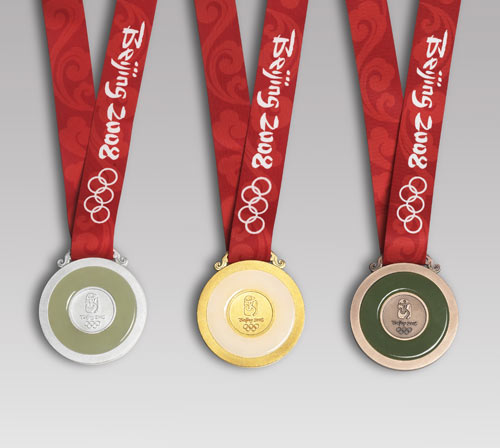The names of the individual sports were engraved on the medals after pressing. The following process involved spraying lacquer over the medals to protect their surface. But the lacquer had to be evenly sprayed without changing the color and luster of the medal's surface.
Because the jade rings did not arrive in Shanghai on schedule, much of the jade inlay work had to be carried out in June, the rainy season in Shanghai. Indoor humidity reached 80-90 percent. Moisture and sulfur in the air might easily have altered the surface color of the silver and bronze medals.
In response, the Shanghai Mint urgently equipped four powerful moisture reducing machines to lower the humidity level. In addition, all workers were required to wear face masks to prevent breath and saliva from harming the medals. "The medals represent a lifetime's achievement for the competitors. It would be disappointing if the colors were to change with the passage of time. So we took great care."
 |
|
Reverse side of the Medal and the Ribbon (BOCOG)
|
Olympic medal production is subject to zero defect. In order to meet the standard, the gold plating had to be strictly controlled. "The gold medal is not of pure gold. It is made of pure silver, plated with no less than six grams of gold. Any medals with less than six grams of gold plating were rejected."
In order to ensure the exact weight of the plated gold, the workers had to control the duration of the electroplating and the strength of the electric current. Additionally, uneven color distribution over the medal surface was not acceptable.
Each medal was weighed before being put into the electroplating bath. To better control time and achieve the right finish, medals for electroplating were batched together according to weight. Eventually each medal was plated with 6 to 6.1 grams of gold.
In order to improve the look of the medals, the top end of the ribbon clasp was designed with a point. During bulk production processes after the clasps had been welded, there was a risk of medals scraping against each other. To avoid medals getting scratched, the staff at the Mint designed a number of protective measures such as the "safety bag" – each medal was stored in a soft paper bag.
All the staff at the Mint treated the Olympic medal making task with the utmost seriousness. They had not only to guarantee the quality of medal production within their time deadlines, but also to ensure the security of the medals. Strict quality control measures were implemented to guarantee the safety of the materials and the quality of the final product. Employees also signed a non-disclosure agreement forbidding them from talking to their families about the making of the medals.
(China.org.cn by Zhang Ming'ai and Yang Xi, August 8, 2008)